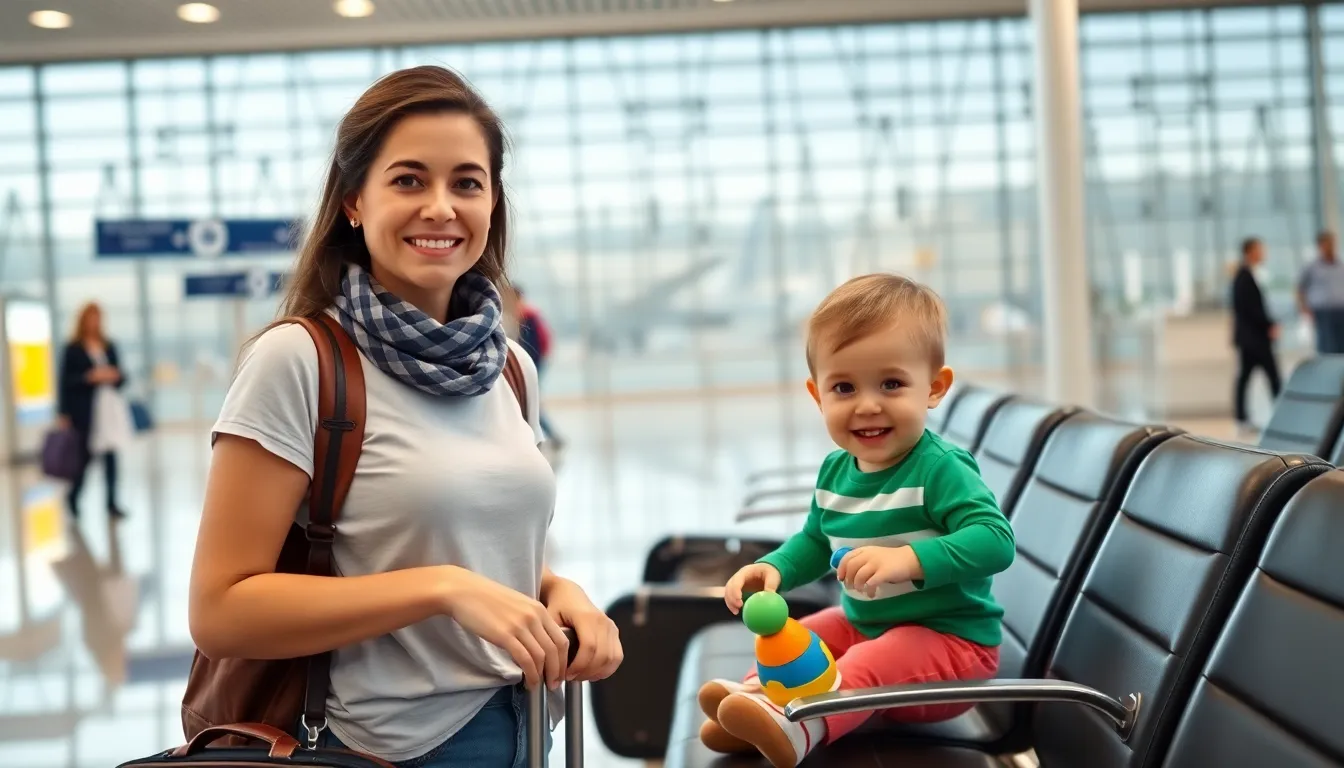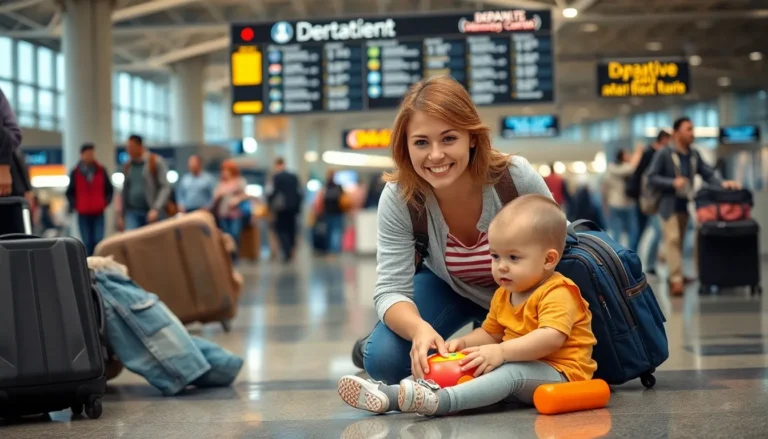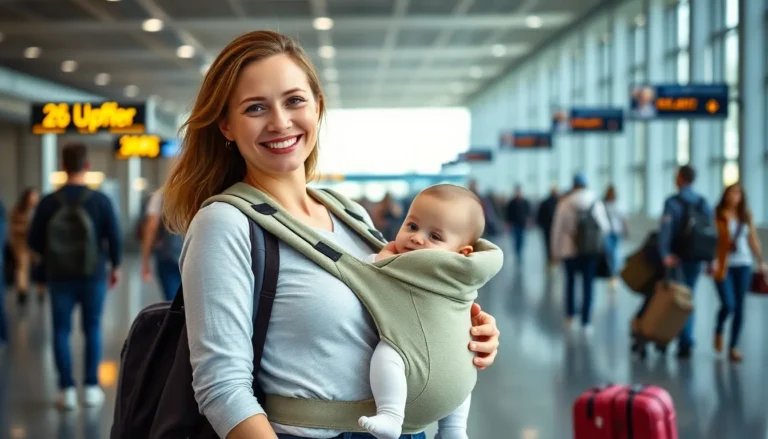Flying with a two-year-old can feel like preparing for a high-stakes mission, complete with unexpected turbulence and surprise meltdowns. But fear not! With a little planning and a sprinkle of humor, parents can transform their travel experience from chaos to calm. Imagine breezing through the airport while your toddler is happily entertained, rather than engaging in an epic battle over a snack or toy.
Table of Contents
TogglePreparing for the Flight
Preparation proves vital for a smooth journey with a two-year-old. Parents can ease the experience with thoughtful planning and organization.
Choosing the Right Flight Time
Selecting flight times that align with a toddler’s routine can minimize disruptions. Early morning flights often coincide with nap times, reducing fussiness. Flights during the late afternoon or evening can also help, as many toddlers tend to doze off easily then. Consider shorter flights or direct routes to decrease travel stress. Avoid peak travel times, which increase the likelihood of delays and crowd-related stress.
Packing Essentials for Your Toddler
Packing strategically ensures all necessary items are on hand. Include snacks such as crackers or fruit pouches, as hunger can lead to tantrums. A favorite blanket or stuffed animal can provide comfort during travel. Include interactive toys or coloring books to keep toddlers engaged. Don’t forget extra clothing for potential spills or accidents. A lightweight stroller can help navigate the airport, while a car seat may enhance safety during the flight.
At the Airport

Flying with a two-year-old at the airport involves careful planning and adaptability. Keeping the travel experience smooth requires attention to details.
Arriving Early
Arriving early reduces stress and provides ample time for various activities. Ensure the family has time to check luggage, grab snacks, and navigate through the terminal without feeling rushed. Settle in at the gate and allow toddlers to explore the seating area. Engaging children in these spaces helps prevent restlessness before boarding. Plan for extra time in case of unexpected delays. Less pressure contributes to a calmer experience.
Navigating Security with a Toddler
Navigating security with a toddler can present unique challenges. Remove shoes, jackets, and any large metal items before reaching the screening area. Prepare documents and boarding passes for easy access. Consider carrying a lightweight stroller for convenience but check security rules regarding strollers. Keep toddlers entertained with small toys or snacks while waiting. Minimize fuss by explaining security procedures to your child to foster understanding. Staying calm sets a positive tone, making the process smoother for everyone involved.
During the Flight
Flying with a two-year-old presents its own set of challenges. Preparing ahead can substantially ease this experience.
Keeping Your Toddler Entertained
Interactive toys capture a toddler’s attention effectively. Consider bringing coloring books, small puzzles, or handheld games. Snacks also serve as great distractions; pack favorites to minimize fuss. Download cartoons or educational apps on a tablet for on-the-go entertainment. Engaging toddlers in simple games like “I Spy” or counting objects can keep them occupied while fostering learning. Frequent breaks for stretching, walking the aisle, or visiting the restroom offer movement and promote comfort during the flight.
Managing Sleep Schedules
Aligning flights with your toddler’s sleep schedule optimizes rest during travel. Late morning or early afternoon departures often work well. Bringing along a familiar blanket or stuffed animal can create a sense of security, encouraging sleep. If your toddler typically naps, try scheduling the flight around that time. Calmly settling them in a window seat may facilitate better sleep, as the scenery becomes captivating. Utilizing a neck pillow or travel blanket further enhances comfort, making it easier for the toddler to drift off in the confined aircraft space.
In-Flight Comfort
Ensuring in-flight comfort enhances the experience for both toddlers and parents. Implementing simple strategies can significantly improve travel experiences.
Snacks and Hydration Tips
Bringing a variety of snacks proves essential. It’s advisable to pack items like cut fruit, cheese sticks, and crackers to keep toddlers satisfied. Hydration is equally important during flights, so parents should carry a refillable water bottle. Sippy cups with spill-proof lids help prevent messes. Plan to offer snacks and drinks at regular intervals, especially during takeoff and landing. This approach keeps energy levels stable and helps manage boredom. Consider including a special treat for motivation and positive reinforcement.
Dealing with Ear Pressure
Managing ear pressure during flights can prevent discomfort. Engaging toddlers in activities like drinking, chewing, or sucking on a pacifier during takeoff and landing helps equalize ear pressure. Parents can also encourage yawning or swallowing to alleviate potential discomfort. Using earplugs designed for children offers additional relief. It’s important to monitor your child’s reactions and provide comforting distractions if needed. Packing familiar comfort items like stuffed animals can help soothe anxiety. Focusing on these strategies makes for a smoother and more enjoyable flight experience.
Post-Flight Considerations
Post-flight transitions can present unique challenges for travelers with toddlers. Adjusting to a new environment requires patience and understanding. Parents should take time to explore the accommodations upon arrival. Allow toddlers to familiarize themselves with the space, toys, and routines. Setting up a comfort zone with familiar items such as blankets or stuffed animals can help ease the adjustment. Encourage toddlers to engage in activities in the new environment to support a sense of security.
Transitioning to New Environments
Toddler reactions to new surroundings can vary significantly. They may feel excited or overwhelmed upon arrival. Gradually introducing them to the new space can ease anxiety. Parents should highlight areas of interest, such as a playground or colorful decor. Seeking opportunities for play can further help a child adapt. Establishing a predictable routine can add structure and comfort during this transition. Consistency in meals and bedtime routines creates a sense of normalcy in an unfamiliar setting.
Managing Jet Lag with a Toddler
Dealing with jet lag requires careful planning and adaptation. Sleep schedules often shift drastically after a long flight. Parents can combat this by adjusting bedtime gradually before departure. Keeping toddlers active during the daytime upon arrival can aid in readjusting their internal clocks. Engaging in outdoor activities exposes them to natural light, which promotes alertness. Hydration also plays a crucial role in minimizing fatigue after flying. Offering frequent drinks helps maintain energy levels. If the child appears restless at night, short calming activities such as reading can facilitate a smooth transition into sleep.
Conclusion
Flying with a two-year-old can be a daunting task but with the right strategies in place it can also be a rewarding experience. By prioritizing preparation and maintaining a lighthearted attitude parents can navigate the challenges more effectively.
Choosing optimal flight times and packing essential items can significantly enhance comfort and minimize stress. Engaging toddlers with interactive activities during the flight can keep them entertained and help manage their energy levels.
As they transition to a new environment after the flight it’s important to create a familiar space and establish a routine. With patience and creativity parents can turn travel into an adventure that both they and their toddlers will cherish.



